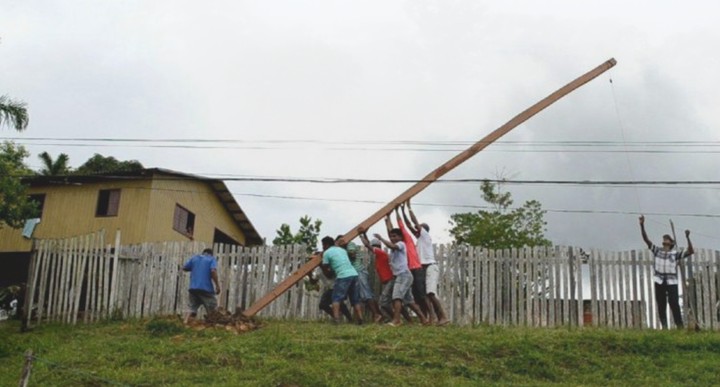Fonias Jurua Project
 Raising a high site. Photo credit: Fonias Jurua Project.
Raising a high site. Photo credit: Fonias Jurua Project.Executive Summary
The Fonias Juruá Project currently comprises of six radio stations in the Amazonian rain forest of Brazil, close to the Peruvian border. Using a software capable of generating a signal compatible with the HamDRM standard, photos are transmitted from one station to the other, effectively proving the use of the Short Wave band for digital data transmission using the same radio transceiver used for voice communication. The project seeks to set up GSM base stations in the near future.
Keywords: digital transmission using HF bands, community network, telehealth, rural, Amazon
Context
Amazonian communities are often “beyond the last mile.” Some of them are over a day away by boat to their near nearest public landline telephone, and lack a continuous source of electricity. Attracted by access to services, most of these communities have relatives in urban areas but lacked a means of communication with them.
+—————–+—————–+—————–+—————–+ | Brazil | | | | +=================+=================+=================+=================+ | Population | 203,657,210 | **Fixed | 12.97 | | | | broadband | | | (UN, 2015) | | subscriptions | | | | | (%) ** | | | | | | | | | | (ITU, 2016) | | +—————–+—————–+—————–+—————–+ | Population | 23.92 | **Mobile | 118.92 | | density (people | | cellular | | | per sq.km) | | subscriptions | | | | | (%) ** | | | (UN, 2015) | | | | | | | (ITU, 2016) | | +—————–+—————–+—————–+—————–+ | Median | US$ 7,522 | **Individuals | 59.7 | | household | | using the | | | income | | Internet (%) ** | | | | | | | | (Gallup, | | (ITU, 2016) | | | 2006-2012) | | | | +—————–+—————–+—————–+—————–+ | Education | Male: 7.2 | Individuals | Male: 59.2 | | | | using the | | | (Mean years of | Female: 7.3 | Internet by | Female: 57.6 | | schooling) | | Gender (%) | | | | | (ITU, 2016) | | | (UNDP, 2013) | | | | +—————–+—————–+—————–+—————–+
Project Description
Six HF radio stations have been set up - five of which located within the Alto Juruá Extravitiate Reserve and one at the headquarters of the association that represents the reserve, in the municipality of Marechal Thaumaturgo in Acre. In the pilot phase, using a software capable of generating a signal compatible with the HamDRM standard, digital transmission of photos between two stations has occurred. The base infrastructure for radio communication in the rainforest that existed during the cold war, is used in an innovative way to enable modern day communication for these communities.
The project aims to develop a reproducible HF digital radio communication solution by using HF radio transceivers connected to an embedded modem. Each node comprises a HF transceiver, an embedded computer, an interface to connect the two, an antenna, a battery, a solar panel and cables – and costs approximately US$ 6000 in total.
As signals in the HF band provide a very large coverage area, digital transmission can enable the use of the same to provide connectivity to hitherto unconnected communities. During the testing phase, signals from Brazil, Bolivia and Peru were intercepted, and communication was also established with a station in Peru.
Project details
Technology Digital short-wave HF band transmission Training Training for locals Year program started 2010 Cost to users Free Geography Rural, jungles in the Amazon Total cost of program US$ 6000 per tower User profile Rural, low-income communities; tribes Associated organizations Internet Society
Progress and Results
Communities in the six locations within the Amazonian rainforest have now been able to establish voice communications using radio waves, and are able to use the connectivity to draw attention to health emergencies and seek help from local authorities. Further, the communication link enables them to communicate with their family members, and relay safety messages.
The project team is presently designing experiments to test the viability of the link in providing services to the school and the local health center, in two of these locations. The goal is to enable file transfer using the HF band, in order to provide education and healthcare related information tailored to the needs of the community.
Challenges
High infrastructural cost: Fiber optic networks, local Internet service providers, or terrestrial line-of-sight radio are not viable options due to the high cost of infrastructure and equipment to deploy the network in these communities, which are among the poorest in the world.
Lack of easily available backhaul: Reservations in the middle of the Amazonian rainforests lack access to a lot of transportation infrastructure, and have no viable access to backhaul.
Manpower for deployment: Local communities were galvanized to provide the manpower to lay the infrastructure in collaboration with the project team, owing to the short supply of high skilled technical labour in the region.
Fonis Jurua’s Suggestions for Future Projects
Innovative solutions using existing infrastructure must be experimented with, for difficult terrains –Radio wave bands can provide an innovative solution to connecting communities that are in hyper-remote areas that face significant infrastructural barriers. In this case, some of the cold-war era infrastructure was leveraged in order to provide connectivity to communities that had no access to means of communication.
Partnerships with local communities is key – Collaboration with local communities helps with successful implementation of projects and maintenance over a longer period of time
Sources
Orlova, A. (2016, December 9) Personal Interview.